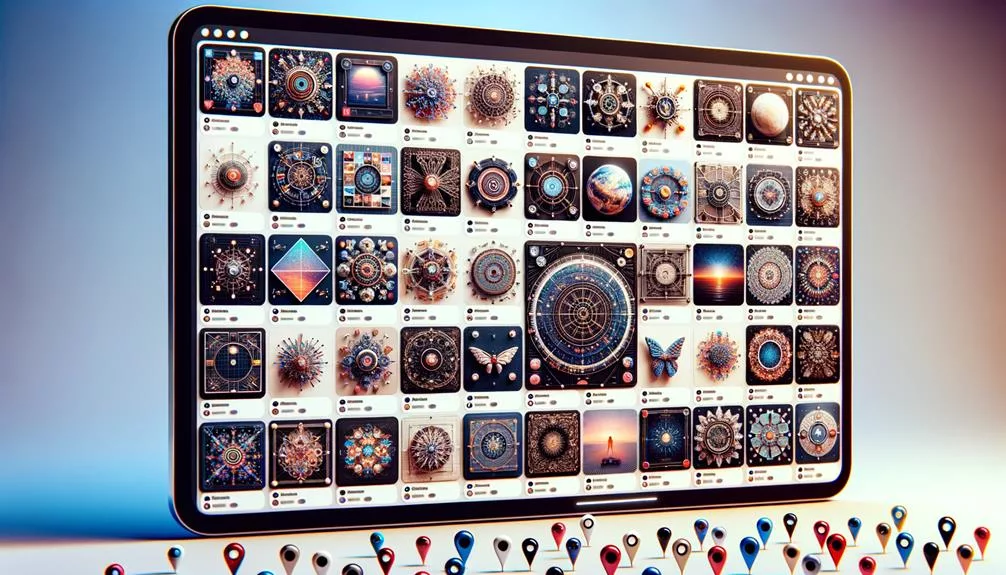No products in the cart.
So, you’ve heard about making money on Pinterest without having to deal with the hassle of maintaining a blog.
You might be wondering if it’s really possible. Well, the good news is that it is entirely possible, and there are several strategies that can help you achieve this.
From leveraging creator rewards to creating pin templates that sell, there are numerous avenues to explore.
But how exactly can you tap into these opportunities and start generating income? Stick around to find out how you can turn your Pinterest presence into a profitable venture without the need for a blog.
Key Takeaways
- Utilize Pinterest’s Creator Rewards program to earn money for creating idea pins, even without a blog or website.
- Collaborate with brands for sponsored content and negotiate compensation for idea pins.
- Maximize earnings potential by engaging in affiliate marketing through affiliate pins and idea pins.
- Diversify revenue streams by selling digital products such as pin templates and digital assets on platforms like Etsy or Creative Market.
Creator Rewards
To start earning money through Pinterest’s Creator Rewards program, you need to create engaging idea pins that resonate with your audience and meet the program’s eligibility requirements. As of July 2022, the program is still in beta testing, and to participate, you must use the mobile app and have a minimum of 250 followers.
Once eligible, you can access Creator Rewards in the Creator Hub tab on the app. The program allows Pinterest users to earn money for creating idea pins, with past creator reward goals including publishing an idea pin each week and earning $250. This presents an opportunity to make money on Pinterest without relying on a blog or website.
Sponsored Content
When collaborating with brands for sponsored content on Pinterest, creators can pitch their ideas and negotiate compensation for their sponsored idea pins. This allows you to monetize your Pinterest presence without a blog by partnering with brands for paid promotions. In the table below, we outline the potential earnings and benefits of sponsored content on Pinterest, as well as the steps to get started with sponsored pins.
| Potential Earnings | Benefits |
|---|---|
| Earn from brand partnerships | Increase visibility and reach potential customers |
| Monetize Pinterest presence | Establish authority in your niche |
| Create passive income | Collaborate with reputable brands |
| Sell products through pins | Diversify revenue streams |
| Affiliate marketing | Connect with a Pinterest Virtual Assistant |
To get started with sponsored content, utilize Pinterest’s branded content tab to connect with brands and create contracts for sponsored pins. This avenue not only offers a steady income stream for content creators without a blog but also provides an opportunity to engage in affiliate marketing and sell products through Pinterest. By leveraging sponsored content, you can turn your Pinterest marketing efforts into a source of passive income.
Affiliate Marketing

When implementing affiliate marketing on Pinterest, consider searching for niche-specific affiliate programs to maximize your earnings potential. Finding approved affiliate programs that align with your Pinterest content can help you earn some extra money by promoting products or services through affiliate links.
By using affiliate marketing, you can earn a commission on any sales generated through your affiliate links, making it a lucrative opportunity for Pinterest Creators.
Here are some tips for using affiliate marketing effectively on Pinterest:
- Research and join approved affiliate programs for Pinterest, such as Amazon Associates, ShopStyle Collective, and Rakuten Advertising.
- Create engaging affiliate pins that provide value to your audience and seamlessly incorporate affiliate links.
- Collaborate with brand partners to create idea pins with approved affiliate partners, where the brand pays you a commission on sales generated through the idea pin.
Create Pin Templates
Consider creating pin templates in Canva to offer valuable and customizable designs for purchase by social media marketers and bloggers. By creating visually appealing pins, you can cater to the growing demand for eye-catching content on Pinterest. Utilize Canva’s template function to develop original and customizable pin templates, ensuring they align with Canva’s guidelines for selling pre-made templates. Selling these templates can be done on platforms such as VA Facebook groups, Etsy, or Creative Market, allowing you to reach a wide audience.
| Key Points | Details |
|---|---|
| Target Audience | Social media marketers and bloggers |
| Platform for Selling Templates | VA Facebook groups, Etsy, Creative Market |
| Design Approach | Original and customizable designs tailored for Pinterest users |
| Selling Guidelines | Adhere to Canva’s guidelines for creating and selling pre-made templates |
| Marketing Strategy | Highlight the value of your pin templates in content marketing and creating idea pins |
With an eye for design and an understanding of the need for captivating pins on a visual platform like Pinterest, you can use affiliate marketing to your advantage by offering products or services that cater to the demand for visually engaging content. This can be an innovative way to capitalize on the popularity of Pinterest and generate income without needing a blog.
Sell Digital Products

To sell digital products on Pinterest, leverage your creative skills to develop appealing and valuable offerings that cater to the platform’s audience. With a Pinterest business account, you can tap into various opportunities to make money and showcase your digital products to a targeted audience.
Here’s how you can do it:
- Utilize Pinterest’s Creator Rewards program: Earn money for creating idea pins by partnering with brands and including sponsored content in your pins.
- Engage in affiliate marketing: Create affiliate pins and idea pins with approved affiliate partners on Pinterest to earn extra cash through commissions and promotions.
- Sell pin templates and digital assets: Design pin templates in platforms like Canva and sell them on Etsy or Creative Market to offer valuable resources to other Pinterest users.
Frequently Asked Questions
How Do Beginners Make Money on Pinterest?
To make money on Pinterest, as a beginner, focus on affiliate marketing, product promotion, sponsored pins, e-commerce integration, graphic design, niche targeting, pin creation, content curation, Pinterest ads, and engagement strategies. These avenues offer potential for lucrative earnings.
Can You Make Money on Pinterest by Posting Pictures?
Yes, you can make money on Pinterest by posting pictures through affiliate marketing, sponsored content, product promotion, digital products, e-commerce, influencer partnerships, ad revenue, affiliate links, brand collaborations, and direct sales. It’s a versatile platform for monetization.
How Many Followers Do You Need on Pinterest to Earn Money?
To earn money on Pinterest, you can utilize affiliate marketing, sponsored content, product pins, promoted pins, Pinterest ads, influencer collaborations, e-commerce sales, affiliate links, digital products, and Pinterest courses. Aim for a substantial follower count to maximize your earning potential.
How Do You Make Passive Income on Pinterest?
To make passive income on Pinterest, engage in affiliate marketing, product promotions, sponsored pins, e-commerce opportunities, and digital downloads. Leverage Pinterest ads, niche targeting, content creation, and engagement strategies while analyzing Pinterest analytics to optimize results.
Conclusion
In conclusion, there are several ways to make money on Pinterest without a blog. By utilizing creator rewards, sponsored content, affiliate marketing, creating pin templates, and selling digital products, you can generate income and reach a larger audience.
With the visual appeal of Pinterest, it’s a great platform to showcase and sell digital products, and with the right strategies, you can successfully monetize your presence on the platform.






